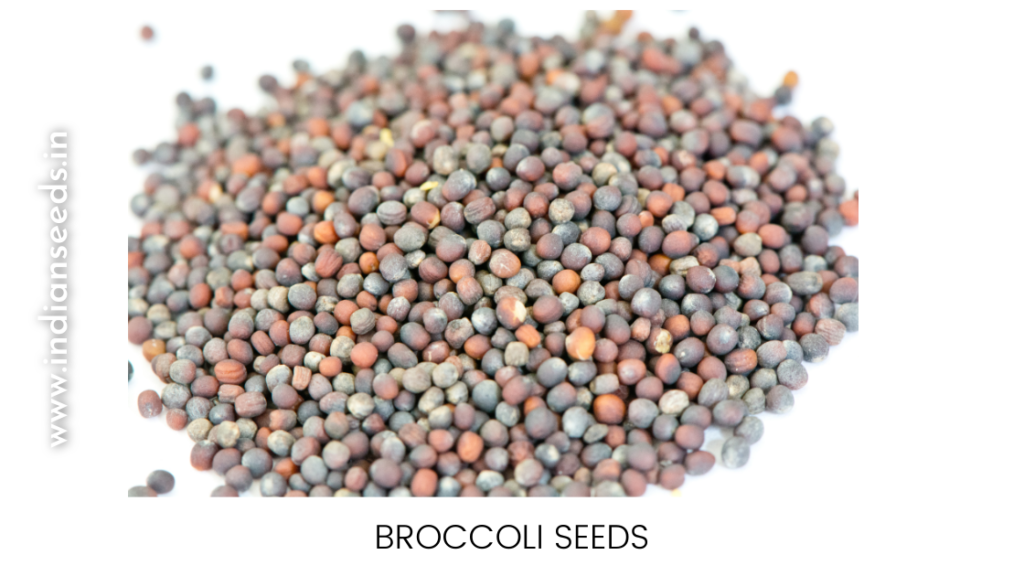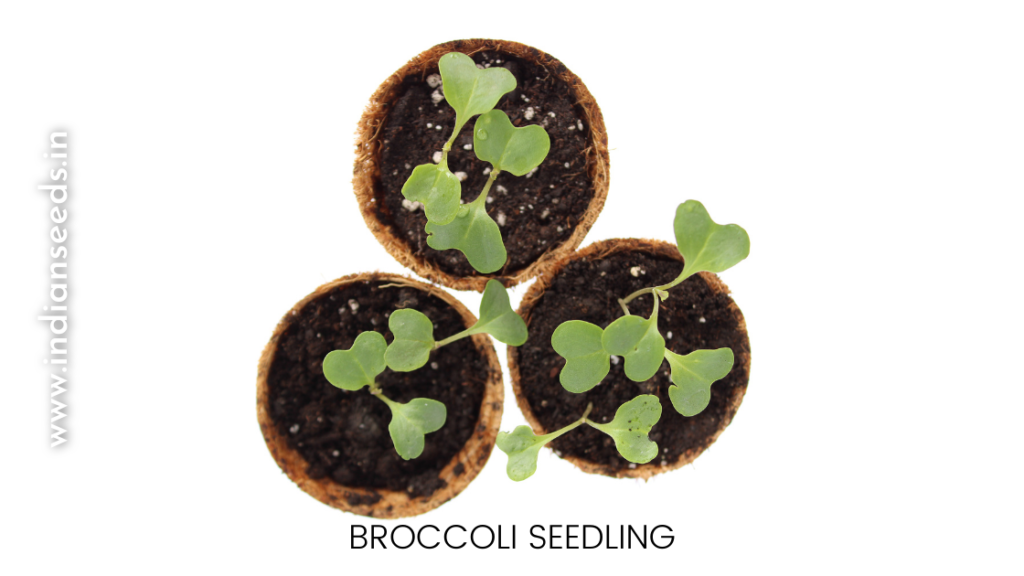Broccoli is a crop that grows best in the cooler months. It flourishes in temperatures ranging from 60 to 70 degrees Fahrenheit (15 to 21 degrees Celsius).
Plants that are mature can resist temperatures as low as 25°F (-4°).
Broccoli can be temperature sensitive; if you plant it too early, it may only produce little heads known as “buttons.” Heads may not form at all if you plant too late, and plants mature in very warm or hot conditions, and plants may merely flower and go to seed.
Plant broccoli in the springtime so that it is ready to harvest before the summer heat sets in. Plant in the late spring or summer so that the plants mature in the cool autumn weather.
How does Broccoli Seeds Look Like?

Broccoli seeds aren’t as big as you might think. I’m not sure why, but I was startled when I first saw them that such a massive plant could produce such small seeds.
The simplest way to describe them is that they are spherical and black or dark brown. Some are slightly oval in shape, and there is normally a tiny white dot on one side (this is where the seedling emerges).
Best time for growing Broccoli Seeds
Broccoli is a vegetable that grows best in the cooler months. As a result, the best time to grow it is during the cooler months of the year. The high temperatures of the summer months will have an impact on the broccoli plant’s growth. In India, September to November is the best period to plant broccoli.
Start by sowing broccoli seeds indoors in the middle of the summer and transplanting them to their ultimate site once the seedlings are approximately 5-6 inches tall.
Step by Step method of Growing Broccoli Seeds
Though you will need a few items to start broccoli seeds inside, you will not need to invest in a lot of expensive machinery. You should have everything you need on hand if you already grow other seeds.
The following items are required for growing Broccoli seeds:
1. Flatten the seedlings and cover them with a lid.
2. Seed starting soil or peat pellets that have been pre-moistened
3. Seeds
4. Water
Fill your seedling tray with a high-quality seed starting mix, or use pre-moistened peat pellets if you prefer.
Step 2: Determine the number of seeds to plant — You can only plant one seed per hole if you’re using brand new seeds. Otherwise, if they’re old, you might want to plant two or three per hole.
Step 3: Plant your seeds – You may either make a shallow hole in the dirt and drop the seed into it, or you may make a deep hole in the dirt and drop the seed into it. Alternatively, sprinkle the seed on top and gently press it into the soil. Making the holes first is easier for me.
Step 4: Lightly cover the seeds and gently press down the dirt to ensure it comes into touch with the seeds. Broccoli seeds should only be sown 1/8′′ – 1/4′′ deep because to their small size.
Step 5: Add water – Water from the bottom of the trays to avoid disturbing the soil or displacing the seedlings. Pour water into the pan and let the soil absorb it from the bottom up. After 20 minutes, dump out whatever that hasn’t been absorbed.
Step 6: Cover the tray — To prevent the soil from drying up during germination, place the plastic lid on top of the tray. After that, put it in a warm spot or on top of a heat mat.
TIME TO GERMINATE BROCCOLI
Growing broccoli from seed is, for the most part, a quick process. Seedlings begin to emerge from the soil about 5-10 days, depending on how warm the weather is.
If you planted them indoors and want them to germinate more quickly, place the trays on a heat mat.
Broccoli Seedlings Caring Tips
The thought of seeing small flecks of green emerge from the soil excites me. When you realise you have to keep those seeds alive, though, the thrill fades rapidly. Yikes!
Don’t be concerned; you’ve got this. I’ve included some thorough broccoli seedling care guidelines below to assist you. You can also learn more about seedling care in general by clicking here.
LIGHT
Broccoli seedlings grown indoors require a lot of light to avoid stretching and becoming lanky. As soon as they start to emerge from the dirt, make sure to add a grow light.
At all times, the light should be a few inches above your seedlings (move the light up as they grow taller). It should be worn for 14 to 16 hours per day.
You can either buy a good lighting system or create your own to make things easier. Using an affordable fluorescent light fixture and plant grow light bulbs, I created my own seed beginning lights.
Whatever method you choose, I highly recommend investing in an affordable outlet timer to automate the lighting control process; it’s far more convenient than relying on your memory.
WATER
Keep the soil uniformly moist from the time you plant broccoli seeds until they sprout. It should never be fully dry, but neither should it be wet.
If the soil is too dry or too wet, the seedlings will not thrive, and poor watering might cause to problems down the road.
So, at least once a day, check the moisture level and water as needed to maintain it moist. A soil moisture gauge can assist you in getting it just right.
It’s also a good idea to water the trays from the bottom instead of pouring water on top. You won’t mistakenly harm the fragile seedlings this way.
CIRCULATION OF THE AIR
It’s a good idea to start giving the seeds in the tray some fresh air once the majority of them have germinated. This will help to keep mould at bay while also strengthening the seedlings.
Begin by propping the lids open for a few days before completely removing them. Once the seedlings develop their first genuine leaves, you can gently blow in them with an oscillating fan set on low.
Just keep in mind that once the lids are removed, the soil will dry out much more quickly (especially with the fan). Check on them several times a day to ensure that they aren’t drying out too much.
FERTILIZER
Broccoli plants are heavy feeders, therefore it’s critical to fertilise them. Feed your seedlings as soon as they sprout their first true leaves to give them a head start in life.
Start with a little amount of liquid fertiliser and gradually increase it as the plants grow.
Indoors, I recommend utilising an organic compost fertiliser in liquid form or buying tea bags and brewing your own.
I switch to fish emulsion or liquid kelp after I take them outside. Broccoli seedlings adore them, though they can be a tad smell if used inside.
THINNING
You’ll need to trim the seedlings as they start to grow if you planted more than one seed per cell or pellet, or if you sowed them close together outside.
If they’re too close together, their growth will be stunted, which is something you don’t want. So, when your broccoli seedlings reach a height of a few inches, pick the strongest one and thin the others.
However, don’t take them out because you can damage the delicate roots of the one you wish to maintain. Instead, cut them off at the soil level with a fine pair of micro-tip snips or bonsai shears.
BROCCOLI SEEDLINGS REPOTTING
When your seedlings have grown tall enough to outgrow the trays, pot them up into larger containers. They’ll have plenty of room to expand this way.
If the seedlings are taller than the height of the cells, or roots are sprouting out of the bottom, they need to be repotted.
To make transplanting easier and to avoid disturbing the roots more than once, I like to use plantable pots.
Peat pots are excellent. However, if you want to try something more environmentally friendly, coco coir or cow pots work well.
Of course, instead of plantable pots, you might use small plastic nursery pots. They may be reused, which is convenient.
Transplanting Broccoli Seedlings

You can skip this section if you planted broccoli seeds directly in your garden. If you began them indoors, though, be sure to read these transplanting recommendations.
It’s a delicate procedure, and you don’t want all of your hard work producing broccoli from seed to be for nought if you make a mistake. So don’t overlook these crucial tasks.
WHEN SHOULD YOU TRANSPLANT?
Broccoli seedlings can be planted in your garden 2-4 weeks before your typical last frost date in the spring because it is frost tolerant. If it makes you nervous, there’s no reason you can’t wait until your final frost.
Regardless, you should never plant seedlings into your garden until they have their first few sets of genuine leaves. Here’s how to figure out when to transplant seedlings.
THINKING ABOUT HARDENING OFF
But hold on! You must first harden your broccoli seedlings before you begin transferring them. They’ll have to adjust to the harsh weather outside because they’re used to live in a comfortable inside setting.
So make sure you don’t overlook this step, otherwise, your spoiled seedlings will perish as soon as they’re planted outside.
Start by putting them outside in a shady, protected area for a couple of hours. Then, each day, leave them outside for a bit longer, gradually increasing their exposure to sunshine.
Once they’ve become acclimated to being outside in the light all day, they’ll be ready to go into the garden. Learn how to harden seedlings before transplanting them in this article.
WHERE SHOULD I PLANT MY TREES?
Though there are smaller types that do well in pots, broccoli thrives when planted in the garden with lots of room.
It also requires rich, healthy soil to create enormous, attractive heads. As a result, you’ll need to add compost, well-composted manure, or worm castings to poor-quality soil.
At planting time, I recommend adding a high-nitrogen fertiliser into the soil. Slow-release granules or root-zone feeding packs are both options.
SPACING
Broccoli plants require a lot of space, so don’t crowd them. Because of the overcrowding, their growth will be stunted, resulting in smaller heads (or none at all!).
Plant the seedlings 12-24 inches apart (or direct sow the seeds) for the greatest results. Read the seed packs carefully for specific spacing guidelines for each type.
When the seedlings are small, it will appear strange, and you may believe you have left too much space. But believe me when I say that after the plants reach full growth, they will perfectly fill in space.
IN-DEPTH PLANTATION
Broccoli seedlings should not be planted too deeply. They should be placed at the same depth as in the seed tray or pot where they were growing. Just make sure you cover all of the roots.
Harvesting Broccoli

For first-time gardeners, deciding when to start picking green veggies might be difficult. When the heads of broccoli are formed, they are ready to land on your plates. Harvesting time varies depending on the type of broccoli you’re producing; they’re normally ready when the diameter of the broccoli reaches 4 to 7 inches. Early in the morning, when the broccoli head is firm and tight, is the finest time to harvest.
Remove the broccoli heads and about 6 inches of stem from the plant. The majority of broccoli plants allow for several harvests. Harvest your plant as soon as you notice yellow petals forming on it since the quality of the product will continue to deteriorate.
You’ll be able to reap the benefits of your efforts in about 50-60 days after planting.
Please let us know your feedback on this article on seed viability test in the comments👇










